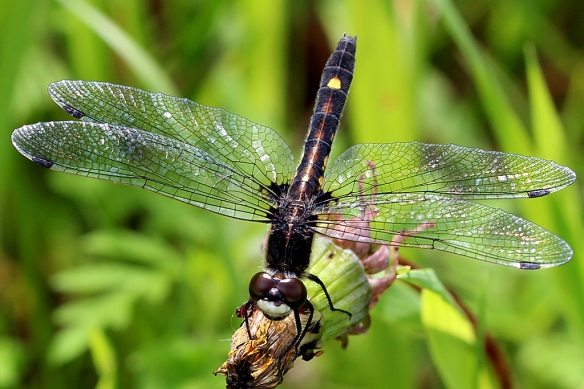Only a week after our first trip to the Glacial Lakes area prairies, we saw new plant species flowering and a different set of animal species moving about. My expectations were low because of the lousy weather (storms), but that didn’t seem to affect the wildlife — in fact, it seemed animals were on the move, perhaps trying to tell us to get out of the way of the weather!

Dragonflies weren’t numerous, but there were a few species I had not seen yet in my own backyard, like this 4-spotted Skimmer. It indeed has four spots on its wings, but there are two additional spots near the abdomen (making this a 6-spotted Skimmer instead).

The Dot-tailed Whiteface is well-named for its standout features and were more numerous than other dragons. The male has a singular square-shaped dot on its abdomen; females have several more dots, but keep the terminal square-shaped one.
Both of these dragonfly species were far from water, hovering over vegetation on the dry prairie, perhaps in search of the numerous mosquitoes there.

I flushed a Lark Sparrow from the ground and was certain it was sitting on a nest there, but couldn’t find it. The bird sat in a tree 100 feet away and chipped at me. What a striking little sparrow with its dark facial and crown stripes and black dot on its breast.
Lark Sparrows are commonly found in farm fields and grasslands. They have the unusual habit of taking over taking over old mockingbird or thrasher nests as its own — sometimes before the previous owner has finished incubating its eggs. The male struts around like a turkey during courtship, erecting and fanning his tail feathers and drooping his wing feathers to the ground, before presenting the female with a twig as her copulatory gift.

We saw numerous flocks of White Pelicans and Double-crested Cormorants flying in V formation overhead, away from the incoming weather front. Later that day we heard there were tornadoes sighted just a few miles away.
Animals can sense the radical changes in barometric pressure that precede extreme weather — meaning, we should pay attention to their behavior and seek shelter as well. Some animals can also hear the infra-sounds (ultra low frequency) produced by stormy weather, earthquakes, or flash floods occurring far away. Another good reason to watch what they are doing.

Blue Flag Iris were blooming in the wetter areas of the prairie. Blue Flag is a tall, showy plant that grows in clumps in roadside ditches, wet meadows, and along lake shorelines, often even in standing water in the northeastern U.S. and eastern Canada.

Prairie Larkspur is diminutive compared to the horticultural variety we have in our gardens. White, spurred flowers on a tall, slender stalk stand out among the prairie grasses though. Flower stalks might stand 3 feet tall and support as many as 30 flowers — very attractive to bumblebees.

Prairie Phlox has sticky stems and leaves, a sweet smell, and an attractive landing platform for its butterfly pollinators. Under the right moisture conditions, it can form dense clusters of dozens of flowers to attract its pollinators. A tiny Syrphid fly (upper left) was the only visitor seen this day.

Bright pink flowers of the Prairie Rose lend color to the grassy matrix of the prairie. Its fruits (rose hips) are rich in vitamin C, which humans (e.g., Native Americans) require, but other animals enjoy the entire plant as good forage.
Native prairie grasses (“warm season grasses”) spend much of the summer growing tall before they send up a flower spike in late summer. European immigrant farmers seeded the prairies with “cool season” grasses from their native countries so their livestock would have good nutrition throughout the spring and summer. Because Junegrass blooms early, it is especially sensitive to grazing pressure.












